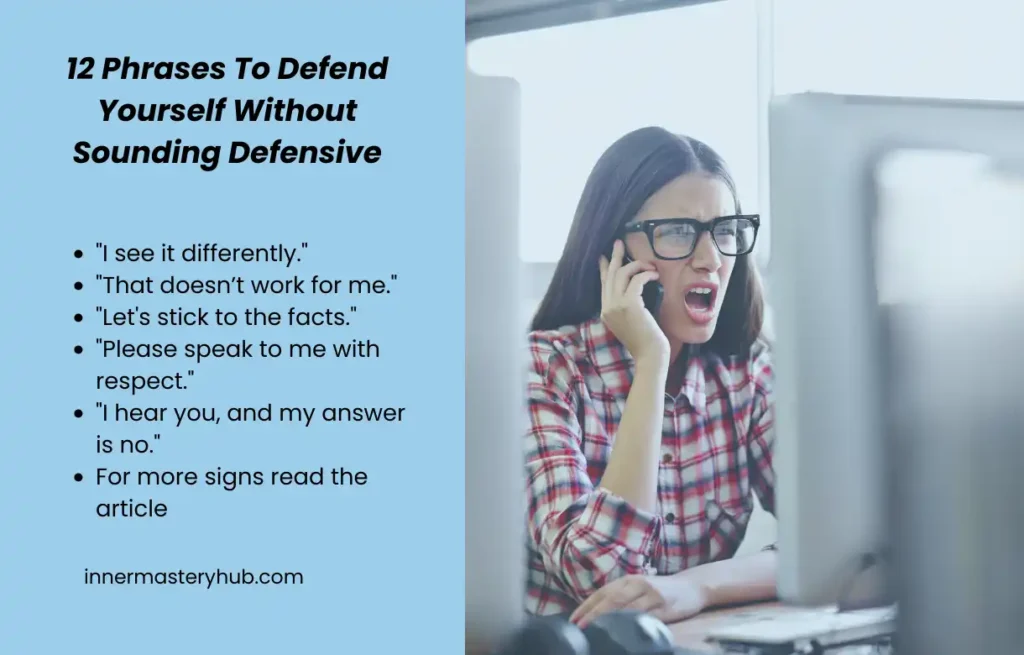
When a conversation takes an unexpected turn, most people either freeze or overreact. The voice tightens, the heart races, and the following sentence either escalates the argument or transfers authority to the other person. Search engines are brimming with advice, but you still need simple, real-world sentences to defend yourself that work under pressure.
Silence allows unfair claims to persist; counterattacks harm trust and reputation. Mistakes can even heighten the risk in heated public encounters. According to research, tailored assertiveness training reduces anxiety while improving communication and mental health, suggesting that effective phrasing enables you to think and act more effectively in a given situation.
Randomised and systematic research have found that assertiveness and de-escalation abilities can help you lower stress, strengthen boundaries, and achieve safer outcomes under challenging interactions.
You can protect yourself with a modest set of statements that emphasise assertiveness, setting limits, and de-escalation. To maintain a calm and uncomplicated structure, each sentence begins with a subject (“I,” “we,” or “this”).
Phrases to defend yourself, listed below, have the context in which they should be used, their explanation, and a brief illustration. The strategy employs evidence-based principles, including assertive communication, de-escalation strategies, and message framing, to reduce defensiveness.
Why do these phrases work to defend yourself?
Across a range of populations, including students and medical professionals, assertiveness training has been shown to improve assertive conduct and reduce anxiety and associated symptoms. In high-risk situations, de-escalation methods help workers manage aggression and reduce the need for forceful control tactics. Although effects can differ depending on the situation, language which stresses I-language typically lowers defensiveness. Therefore, wording should link feeling declarations with standard criteria and a future step.
12 Phrases To Defend Yourself
12 Phrases to defend yourself are listed below:
- “No.”
Use this when a request, invitation, or demand does not fit within your time, energy, or priorities. A direct no works because it is straightforward and does not invite negotiation; over-explaining often allows people to push back. Maintain a calm, neutral tone. “Can you cover my shift tonight?” — “No.”
2. “I’m not comfortable with that.”
Say this when someone crosses a personal boundary—physical touch, private queries, edgy jokes, or duties that feel odd. Framing it around your comfort makes it more difficult to argue and sets a strong boundary without insulting the other person. This is an illustration: “Tell us what your manager said word-for-word.” – “I’m not comfortable with that.”
3. “That doesn’t work for me.“
Use this to decline without explaining the reason for schedules, jobs, or favours that don’t require a big narrative. The neutral phrase decreases defensiveness and allows you to break out of repeated negotiation cycles. For example: “Let’s move the deadline to tomorrow morning.” – “That doesn’t work for me.”
4. “I hear you, and my answer is no.”
This is especially useful when the other person keeps repeating their point or thinks you haven’t listened. Acknowledge their point of view and then restate your decision; this shuts the door while maintaining respect. For instance, “But it’s important to me.” – “I hear you, and my answer is no.”
5. “Please speak to me with respect.”
Use this when the tone becomes unpleasant, dismissive, or degrading. Naming the behaviour maintains a standard without implying rivalry. If it persists, impose a consequence (such as walking away). For instance, “That’s a stupid idea.” – “Please speak to me with respect.”
6. “Let’s stick to the facts.”
Say this when the discourse turns to exaggeration, mind-reading, or drama. Bringing it back to specifics reduces emotion, prevents manipulation, and allows for problem-solving. Example: “You never help around here.” — “Let’s stick to the facts: I handled Tuesday and Thursday.”
7. “I see it differently.”
Use this when you disagree but want to keep it low-key. It indicates that you are not attempting to dominate; instead, you are merely expressing another point of view, which maintains connection and keeps the discourse open. Example: “This plan will fail.” – “I see it differently.”
8. “That’s your opinion; mine is this…”
This helps when someone presents their thoughts as if they were facts. You accept their right to an opinion while asserting your own, preventing your point of view from being crushed. “Remote work is lazy.” — “That’s your opinion; mine is this: it’s efficient for our team.”
9. “I won’t discuss this right now; let’s revisit at ___.”
Use this when your emotions are high, your timing is off, or you require space or information. You’re not dodging; you’re pausing to preserve the conversation’s quality and come up with a clear next step. For example, “We must settle this now!” — “I won’t discuss this right now; let’s revisit at 3 pm.”


10. “I’m responsible for my actions, not your feelings.”
Say this when you’re being guilted for making a decent decision or feeling compelled to regulate someone’s reactions. It draws a clear distinction between healthy accountability and emotional control. Example: “If you cared, you’d do it.” — “I’m responsible for my actions, not your feelings.”
11. “What exactly do you mean by that?”
Use this when you detect a jab, an imprecise charge, or a deceptive comment. Asking for specifics needs clarity, which removes power from deception and indicates whether there is a genuine problem to address. Like this one: “Interesting… for someone like you.” — “What exactly do you mean by that?”
12. “If this continues, I’m ending the conversation.”
This applies to ongoing boundary violations, such as interruptions, insults, or pressure. State the consequence over which you have control, and if the behaviour persists, take prompt action; consistency develops credibility. Example: “You’re ridiculous.” — “If this continues, I’m ending the conversation.” (and then end it if necessary).
Say each self-protecting phrase slowly and only once (maximum twice), maintain a consistent body language, avoid justifying, and follow through on whatever consequences you set. Boundaries function best when they are peaceful, explicit, and constant.
Say them gently, once or twice at most; avoid justifying; maintain an open but steady body language; and, if the boundary is tested, follow through on the consequences you set.
How to use these phrases to defend yourself under pressure
Retention can be developed by practice. When stress levels rise, repetition strengthens accessibility. Training in assertiveness and de-escalation improves your performance in real incidents because repetition reduces cognitive burden during conflicts.
Tone is regulated by structure. Sentences that begin with a subject maintain a consistent voice and easy language. An aggressive-sounding clipped imperative is avoided by the structure.
Body language backs up what is spoken. Maintain a firm eye line, a steady voice, and an open stance to help your message be heard. Deliberate pacing and calm posture are key components of emergency services training in order to keep situational control.
Safety is preserved by boundaries. If threats or insults keep coming, you can leave. Disengagement may be a legitimate first-line response in de-escalation frameworks when circumstances justify it.
How To Practice So The Words Show Up On Time
- Rehearse aloud. Say each phrase three times with a mirror.
- Pair with stance. Add the palm-out gesture and a half step back.
- Record and review. Listen for rising pitch or nervous laughter; flatten it.
- Drill triggers. Pick two personal hot buttons and script your go-to phrase for each.
- Add a witness plan. Decide who you would bring to a tough talk.
Research Snapshot. How to Speak Up and De-Escalate
Assertiveness training can help reduce anxiety and improve everyday communication. More assertive behaviour has been seen in recent RCTs.
Active listening, clear limits, choices, space, and a steady tone are some of the best ways to de-escalate a situation. These help people deal with aggression better, and disengagement is still a good option when the risk stays high. When used with shared standards or a clear next step, “I” language can make people less defensive.
People who teach public self-defence often use short, clear orders, such as “Stop,” “Get back,” and “Leave me alone,” to help individuals remember and warn others. As a way to prevent things from getting worse, rescuers emphasise a relaxed stance, slow pace, and even tone of voice.
The 12 Phrases to Defend Yourself At a Glance
- Stop.
- Back up.
- Please leave me alone.
- I’m willing to talk when we keep it respectful.
- I hear you. I disagree.
- I won’t accept personal remarks.
- That’s not what I said. Here is what I told…
- We may be talking about different things.
- My view is based on evidence.
- This conversation isn’t productive. I’m leaving now.
- I’m not discussing this.
- I will talk later with a third person present.
Final word
You do not need perfect words; you need repeatable ones. These 12 phrases to defend yourself provide a compact toolkit: reject unfair claims, set the tone, buy time, propose solutions, enforce boundaries, and disengage when needed. The wording lines up with evidence from assertiveness and de-escalation research, which links simple, direct language to better regulation, more precise boundaries, and lower risk. Practice a few self-protecting phrases until they feel natural, and your next tough conversation will feel less like a fight and more like a choice.
FAQs about Phrases To Defend Yourself
How do I refuse without sounding rude using a simple self-protecting phrase?
Lead with acknowledgement: “I hear you.” Follow with a clear position: “I disagree,” or “I’m not discussing this.” Keep a steady tone. Avoid justifications that invite debate. Assertive refusals outperform passive or aggressive replies in harassment and moderation studies.
Should I explain my reasons when I set a boundary?
Usually not. One sentence is enough: “I’m willing to talk when we keep it respectful.” Over-explaining invites arguing. If the boundary is ignored, the program will exit. Research on assertiveness supports brief, clear statements tied to specific behaviours.
How to stop someone from twisting my words using a simple self-protecting phrase?
Use a neutral correction loop: “That’s not what I said. Here is what I said…” Repeat once. If the behaviour continues, end the talk. Elgin’s “computer Mode” protects you from emotional bait.
Can these phrases to defend yourself help in public harassment?
Yes. Assertive, brief lines stop many behaviours and help bystanders know what’s happening. Add movement toward people or light. Keep hands visible. Document if safe. Studies suggest that assertive responses are effective in deterring harassers.
Are there phrases to defend yourself that I should never use?
Avoid threats (“I’ll hurt you”), insults, and taunts. These escalate danger and can be used against you legally. Stick to clear commands and boundaries.
What tone works best for these phrases to defend yourself?
Calm, even, and steady. Save volume for simple commands. Pair tone with open hands and a non-challenging posture. This combination communicates resolve without provocation and aligns with de-escalation guidance.
What’s a simple, firm self-protecting phrase to say “no”?
“No.” / “No, I’m not available for that.” / “That doesn’t work for me.”
How can I stop using disrespectful language in the moment by using a self-protecting phrase?
“I can’t continue this conversation if disrespectful language is used.” / “Let’s focus on resolving the issue without insults.
How do I ask for clarification instead of getting defensive?
“What do you mean by that?” / “Can you explain your reasoning?”
What’s a quick self-protecting phrase that keeps me in control?
Say to yourself (silently): “How interesting.” It helps you analyse instead of react.
What self-protecting phrase ends a circular argument gracefully?
“Let’s agree to disagree at this point.”
How can I avoid passive-aggressive digs without a fight by using a simple self-protecting phrase?
“That comment felt off to me. Let’s keep it respectful.” / “I’m going to disengage if this continues.”









